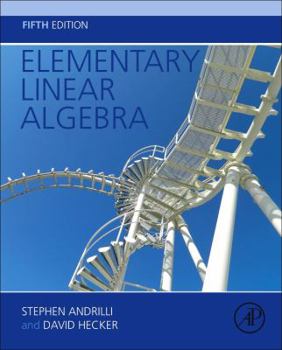Elementary Linear Algebra
Select Format
Select Condition 
Book Overview
Elementary Linear Algebra, 5th edition, by Stephen Andrilli and David Hecker, is a textbook for a beginning course in linear algebra for sophomore or junior mathematics majors. This text provides a solid introduction to both the computational and theoretical aspects of linear algebra. The textbook covers many important real-world applications of linear algebra, including graph theory, circuit theory, Markov chains, elementary coding theory, least-squares polynomials and least-squares solutions for inconsistent systems, differential equations, computer graphics and quadratic forms. Also, many computational techniques in linear algebra are presented, including iterative methods for solving linear systems, LDU Decomposition, the Power Method for finding eigenvalues, QR Decomposition, and Singular Value Decomposition and its usefulness in digital imaging. The most unique feature of the text is that students are nurtured in the art of creating mathematical proofs using linear algebra as the underlying context. The text contains a large number of worked out examples, as well as more than 970 exercises (with over 2600 total questions) to give students practice in both the computational aspects of the course and in developing their proof-writing abilities. Every section of the text ends with a series of true/false questions carefully designed to test the students' understanding of the material. In addition, each of the first seven chapters concludes with a thorough set of review exercises and additional true/false questions. Supplements to the text include an Instructor's Manual with answers to all of the exercises in the text, and a Student Solutions Manual with detailed answers to the starred exercises in the text. Finally, there are seven additional web sections available on the book's website to instructors who adopt the text.
Format:Hardcover
Language:English
ISBN:0128008539
ISBN13:9780128008539
Release Date:March 2016
Publisher:Academic Press
Length:806 Pages
Weight:4.10 lbs.
Dimensions:1.8" x 7.6" x 9.3"
Customer Reviews
2 ratings
Excellent
Published by Thriftbooks.com User , 22 years ago
I used this in my undergrad course as a math major at UT Dallas. I really enjoyed it; the book has sections on applications in just about every chapter, and there are lots of computational exercises as well. In addition to answers to odd-numbered exercises, each chapter has a "self-test" with all the answers provided at the back of the book. It's a bit chatty, but that befits an undergrad text.This is a good book for self-study, though if you are really serious about it, you might want to supplement it with a more rigorous reference (the Dettman text is good for this).
Highly recommended for math majors
Published by Thriftbooks.com User , 23 years ago
I must say I have been pleasantly surprised with this book. I find it very readable. It has been very easy for me to teach myself what I need to know right out of the text. There aren't many math books I've found that can make that claim. I haven't needed to consult any other books to understand the material. The only real improvement I could wish for from this book would be a solutions manual.The book follows a very logical progression. Each topic builds on previously covered material. It's clear to me now why UT chose this book for its math major classes. The emphasis in this book is teaching you to think abstractly and work out difficult proofs, which you're going to need for more advanced math classes. The book has a lot of proof exercises (but there are a lot of computational exercises as well.) In all, I'd say this book does a great job doing what it was designed to do, which is to train future mathematicians. This naturally implies, however, as a previous reviewer stated, that it's going to be short on applications. So if you're going to be taking a class using this book, it would be a good idea to learn a little about the applications of linear algebra before you start, if you need that knowledge to keep yourself motivated. Then prepare to learn linear algebra from a very fine book.






